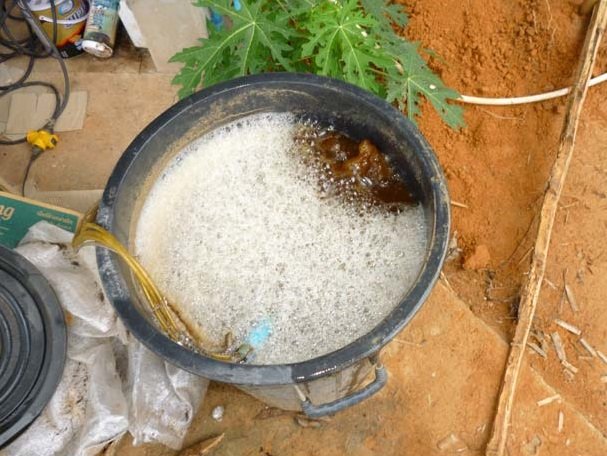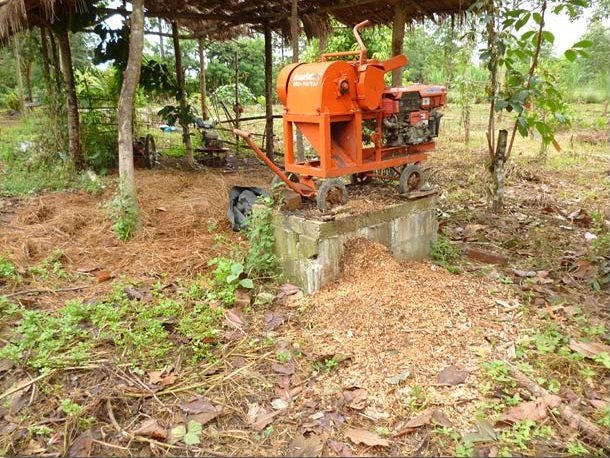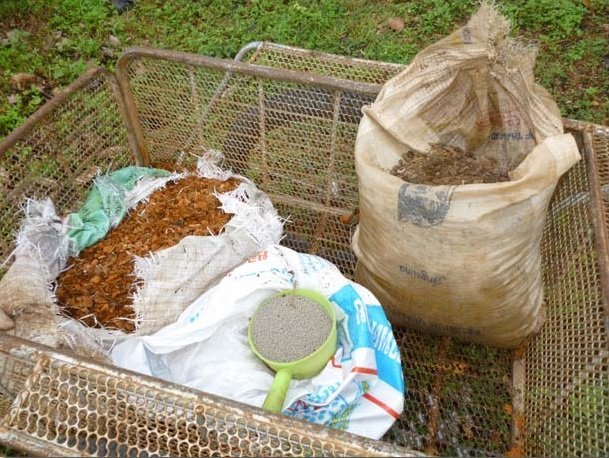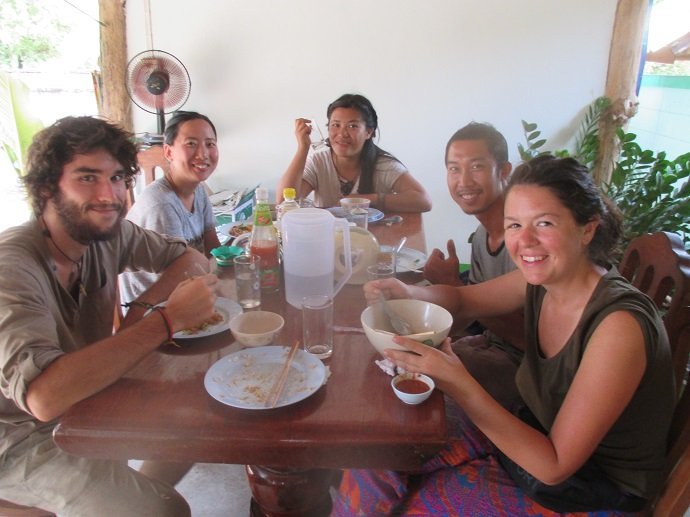
Phayao Permaculture Center, Phayao, Northern Thailand
Having taken the Permaculture Design Certificate (PDC) course with Bill Mollison on Maui, Hawaii in 1982, it has been my vision to retire on my own permaculture designed land. This came about in 2012 when I purchased land for my Thai family.
The design was formulated and implementation began. Of the many elements designed in permaculture fashion, soil enhancement was a major priority from the beginning as the tropical soil on this property was very deficient of nutrients as is typical of some tropical soils.
We consulted with the local Phayao Province government soil office, explained we were developing an organic farm and had soil strategies to make soil alive and healthy in lieu of chemical fertilization. We took soil samples for them to analyze and they came back with the recommendation to add 20-20-20 fertilizer.
O.K. So they didn’t get it.
Permaculture fertilization at the PPC
The permaculture principle is to have a natural, alive and healthy soil. There are only 3 things necessary for an alive and healthy soil and those are the proper proportions of:
1. Air
2. Water
3. Organic matter.
Microorganisms and minerals are already in the soil to activate and bring to life nutrients for plant health. Soil pH is balanced by a living, healthy soil.

Soil origins
Soil comes from the tree and biomass litter in forests. It normally builds at the rate of 1 inch every hundred years. Applying PC principles, mulching, watering, manures, compost teas, etc. we can accelerate the process and build an inch in 3-5 years.

Composting
As Bill taught, we use composting in place at each plant as the major strategy. His slant was that there was no need to create separate compost piles when you can compost in situ. This is simply done by adding elements to the planting area and mulching heavily. This is the process we use here. Elements added include bio-char, wood chips, animal manures, shredded coconut husks with heavy rice straw mulch. In the future we will probably introduce composting to our operation but at this time we are too busy with everything else.

Also, the property was a 4-5 year old rubber tree plantation and one strategy I am implementing is to have the rubber trees replaced by the food forest over time. We are doing this by pollarding the rubber trees and spreading their leaves as mulch and chipping the smaller branches to use as a soil amendment.
Soil building is a major activity in Permaculture and needs to be addressed continually until it has stabilized in the natural process. We here at the Phayao Permaculture Center look forward to increasing soil viability and increasing alive and healthy soils.

The Phayao Permaculture Center is a 2 acre family farm, demonstration and education center in Pa Daeng, Phayao, Thailand. Under the stewardship of PRI Registered Teacher Bruce Bebe, this site is dedicated to the application of Permaculture Ethics & Principles.
Bruce is offering a number of educational and insightful courses.
Permaculture Accelerated Apprentice/PRI Certification Programs for 2016
We are offering accelerated four week permaculture apprentice programs which include the 72 hour PRI certificate program in 2016. The apprentice program is designed to teach the 72 hour certified PC design course based on Bill Mollisons Permaculture, A Designers’ Manual in exchange for 5 hours work on the farm a day, 6 days a week for four weeks apprenticing by helping implement and maintain the Phayao Permaculture Centers’ PC design and farm. The PRI PDC is offered for $500.00 US payable $200.00 pre-registration and $300.00 on arrival. (PayPal or money transfer to our account at Bangkok Bank, Thailand). The simultaneous apprentice program requires five hours of work/labor per day to learn permaculture implementation and maintenance. The PDC is taught 3 hours per day, six days a week for the 4 week apprentice program. Each month’s program is limited to 4 apprentices. If you are interested, register early to insure your place.
Couples welcome.
Schedule: The program is monthly from the 1st to the 28th of each month through 2016.
Accommodation: Free tent camping on site is available, tents provided. There is a Thai Homestay nearby where you can get a room with toilet and shower, A/C and Wi-Fi for 300 Thai Baht double per day. Up to you. You must provide and prepare your own food. There is a kitchen on site where you can prepare your own meals. Wi-Fi on site. Inexpensive food for your preparation is available locally. Budget 100 Thai Baht per day to purchase. There are Thai restaurants nearby where good meals are 30 Thai Baht. It is up to you to care for your needs including food and health care. Bring your own necessities. What you do not bring and need you can purchase locally. We will help and care for you as best we can.
APPRENTICE RESPONSIBILITIES
For certification you must attend all classes, present a PC design plan at completion and optionally participate in the talent show. Additionally, you must read and study Bill Mollison’s PERMACULTURE, A Designers Manual (copy on site), and available as a pdf, prior to each subject taught, study any other permaculture texts you may have, watch DVD’s, do homework, participate in discussions and do trial teaching. Classes are scheduled three hours a day, six days a week for four weeks. The class is in addition to five hours of “work” each day. Work will consist of planting, mulching, watering/irrigation, earthworks, coppicing trees, etc. as necessary at the time of your apprenticeship. Be prepared to take it easy and have a relaxing good time also.
Be adventurous!

DAILY SCHEDULE – FLEXIBLE
Daily 8:00-12:00 am Work
12:00-1:00pm Lunch
1:00-4:00pm Class
4:00-5:00pm Work
5:00pm-Evening: Homework
There are 10 to 15 minute rest breaks scattered throughout the day for rest and rehydration
PERMACULTURE DESIGN COURSE CURRICULUM SCHEDULE
DAY SUBJECT
1 Introduction
2 Phayao Permaculture Center web of life design elements
3. Holmgrens’ Principles
4 Concepts and Themes in Design
5 Methods of Design
6 Pattern Understanding
7 DAY OFF
8 Climatic Factors
9 Trees and Their Energy Transactions
10 Water
11 Soils
12 Earthworking
13 FIELD TRIP
14 DAY OFF
15 Humid Tropics
16 Dryland Strategies
17 Humid Cool to Cold Climates
18 Aquaculture
19 Strategies of an Alternative Global Nation
20 Community
21 DAY OFF
22 Review of 21 Elements and Their Interconnections
23 Review of 21 Elements and Their Interconnections
24 Practice teaching 21 Elements and their Interconnections
25 Work on Design Presentation
26 Work on Design Presentation
27 Design Presentation, Certificates, Talent Show, Graduation
28 DEPART
Also integrated into the course are these twenty one elements and their connections/interactions:
Ethics Agriculture Edge
Observation Animals Succession
Water Aquaculture Zones
Soil Patterning Sectors
Forest Structures Economics
Climate Infrastructures Community/Nation
Energy Earthworks Orientation
If interested register early. Follow your intuition. Be adventurous.
You can contact Bruce via:
His website: https://www.permaculturephayao.com/
Or via email: [email protected]
Bruce Bebe
Phayao Permaculture Center
Phayao, Northern Thailand













Thank you for this great article Bruce. I am looking forward to attending your Permaculture training in Phayao this sunner (2018), and then creating a conscious co-creation program to partner with Permaculture in a multitude of designs.
Blessings